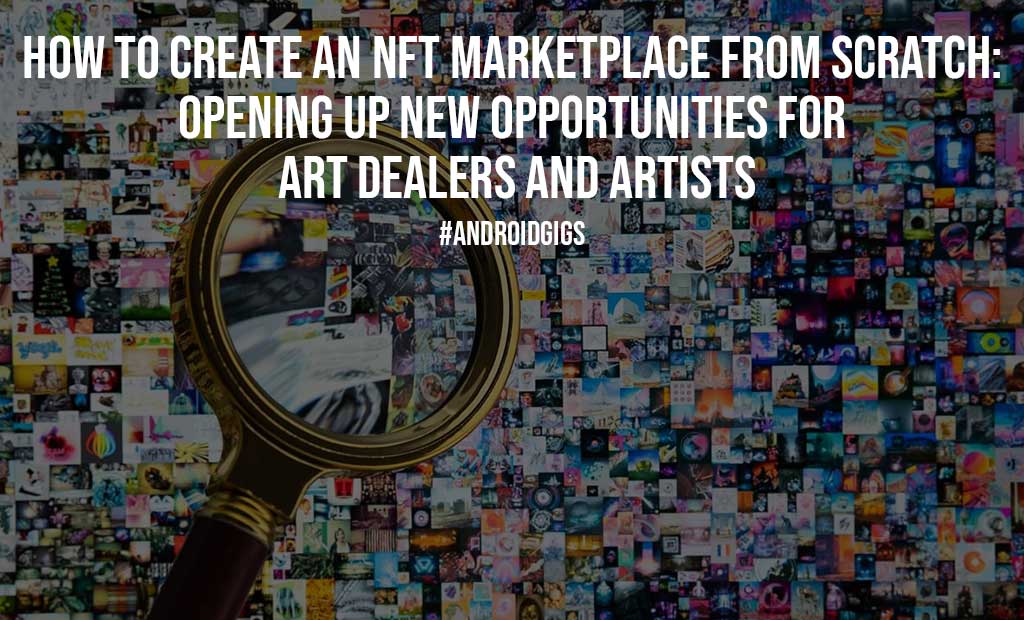The most popular NFT marketplace, OpenSea, had a trading volume of over $5 Billion in January 2022 alone. Such crazy numbers are enough to make you think of how big this new digital form of art collectibles has become. Do you want to create an NFT marketplace website but have no idea where to start?

Do not worry, this article answers your question of how to create an NFT marketplace.
What is an NFT marketplace?
Before you build an NFT marketplace platform, you should know what does an NFT marketplace is. An NFT marketplace is a platform where anyone can create, sell and buy NFTs. An NFT, which stands for Non-Fungible Token, is basically proof of digital ownership of anything. This proof of ownership is secured and verified by blockchain technology.
The most popular blockchain technology for dealing with NFTs is the Ethereum blockchain. The marketplace usually takes some commission from every trade done on the platform, which is huge, which is why more and more people want to start an nft marketplace.
Popular NFT marketplaces:
OpenSea – Founded in 2017, OpenSea has become the biggest NFT marketplace by volume. OpenSea takes 2.5% from every trade done on its platform. It supports various blockchains like Ethereum, Polygon, Klatyn.
SuperRare – It is another marketplace on the Ethereum blockchain. It takes 15% commission from artists’ initial sales and 3% when you sell any NFT.
Rarible – Rarible has a similar commission structure as OpenSea taking 2.5% for each sell of NFT. It is also supported by the Ethereum blockchain.
Some essential features for an NFT marketplace:
An NFT marketplace is used by more users if it has features that make it better than others. So while you create an NFT marketplace website, keep these features in mind.
- Security of the assets – Having an advanced level of security in your marketplace website will help you gain the trust of your audience. There have been so many events of exploitation of NFT marketplaces. Even the biggest marketplace, OpenSea, is also a victim of hacking. Adding some extra cost to increase the security is worth it in the long run.
- Have an advanced search system – Make sure your search system has all sorts of filters that one may need. Have catalogs for different types of NFTs and add categories and subcategories.
- iMulti-Wallet support – This is a very important feature to add when you make an NFT marketplace. Adding multi-wallet integration to your marketplace will help you to expand your marketplace to a larger audience.
- Different Blockchain and Layer support- Most famous blockchain for NFTs Ethereum has become highly congested and expensive to use. Not everyone can pay Ethereum’s high gas fees, and thus you need to add different blockchain like Solana or Ethereum Layer 2 solutions like Polygon, Loopring.
- Additional Features- Add some features like auction, p2p trading, NFTs as collateral for loans, tournaments, limited-time NFTs, etc. You should keep updating your marketplace with additional features to make sure you stay in the game.
Steps to create an NFT marketplace website:
To develop an NFT Marketplace from scratch, one should follow these simple steps.
- Think of a strategy: Brainstorm and prepare a strategy for your marketplace. Ask questions like who your audience will be? How to make your website different from others? What unique features should you add to stand out? What blockchain do you want your marketplace to support? And many more. Once you have answers to these questions, you can start working on the next step.
- UX/UI design: Create the design of your website. Hire front-end developers to make it easier for you. Have a sophisticated design and avoid complexity of any sort. Work on making your website run smoothly and glitch-free.
- Test the prototype: The main aim of creating a prototype is to make sure everything runs perfectly. Hire expert NFT developers to test everything before you take your marketplace public.
- Deploy: Once everything is done and ready to go, release the marketplace and check if things are running as they are intended to.
- Maintain: Add new upgrades regularly and maintain the overall efficiency of the marketplace. Do regular security check-ups to avoid any sort of hacking and breach. Have good communication with artists and creators and listen to their concerns and complaints.
Final Words
By following the above steps, you can create an NFT marketplace website easily. These are only some basic features, but if you want to survive in this competitive space, you need to step up your game and think out-of-the-box. All the Best!
